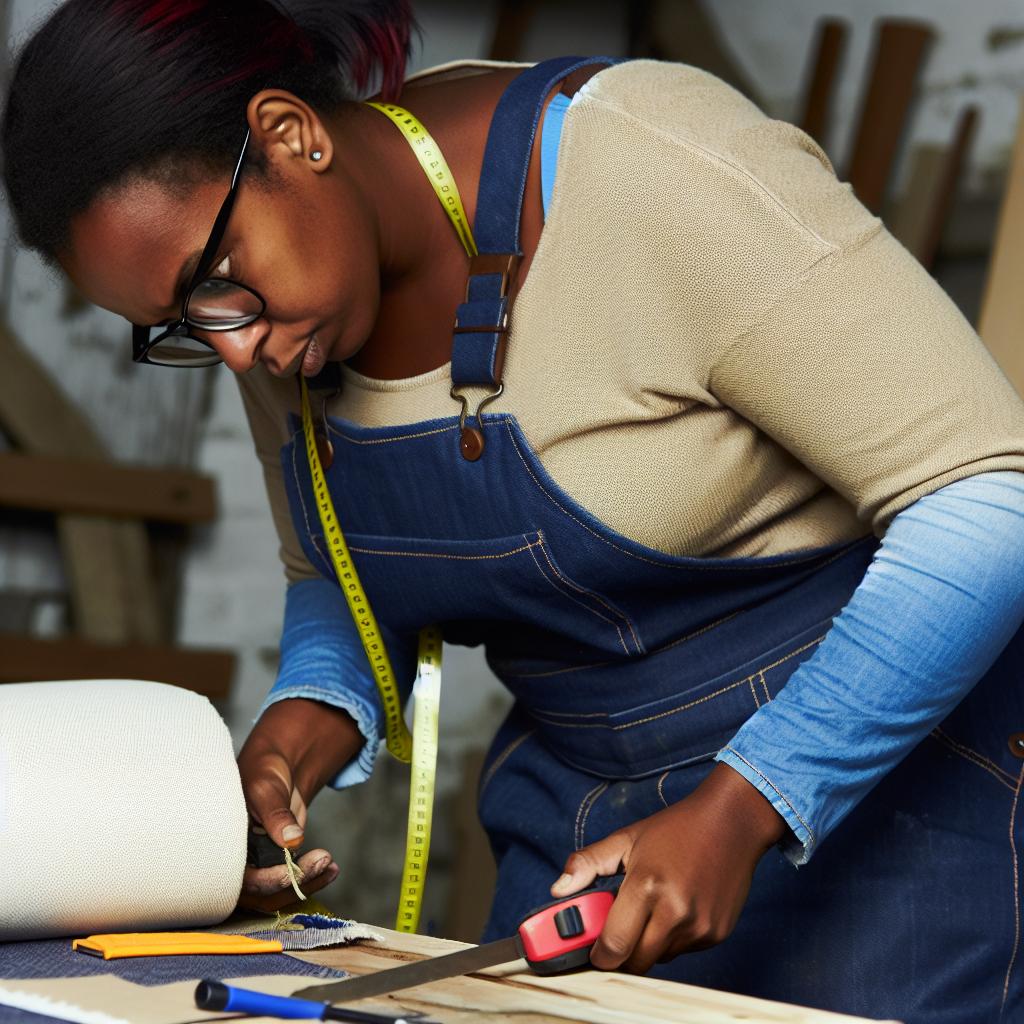Understanding Different Upholstery Materials and Their Uses
Types of Upholstery Materials
Upholstery materials come in various types, each serving unique purposes.
Fabric, leather, and vinyl are popular choices among upholsterers.
Natural Fabrics
Cotton is breathable and easy to clean, making it a popular choice.
Linen offers a crisp look and feels good in warm climates.
Silk provides luxury but requires careful handling to maintain integrity.
Synthetic Fabrics
Polyester is durable and resistant to fading, suitable for high-traffic areas.
Nylon offers great elasticity and is often used in blends for added strength.
Acrylic resembles wool and is water-resistant, making it practical for outdoor use.
Leather Upholstery
Leather is a timeless choice for its durability and easy maintenance.
It ages well and can develop a beautiful patina over time.
However, it can be more expensive than other upholstery options.
Vinyl as an Alternative
Vinyl is an affordable alternative to leather with similar aesthetics.
It is easy to clean and resistant to moisture, making it ideal for kitchens and bathrooms.
On the downside, it may not offer the same comfort level as natural materials.
Choosing the Right Material
Selecting the right upholstery material depends on various factors.
Consider the intended use and the traffic level in the space.
Additionally, account for the desired aesthetic and maintenance requirements.
Understanding these aspects will help ensure a successful upholstery project.
Fundamentals of Furniture Construction and Design
Understanding Furniture Anatomy
Every upholstery professional must grasp furniture anatomy.
This knowledge aids in selecting appropriate materials and techniques.
Familiarizing yourself with frame types is crucial.
Common materials include hardwoods and engineered woods.
Moreover, understanding joints enhances the durability of furniture.
Tenon and mortise joints, for instance, provide strength.
Recognizing Design Principles
Solid upholstery careers begin with strong design principles.
Unlock Your Career Potential
Visualize a clear path to success with our tailored Career Consulting service. Personalized insights in just 1-3 days.
Get StartedLearn about balance, proportion, and scale in furniture design.
Symmetry often creates pleasing aesthetics.
Furthermore, understanding color theory elevates design choices.
Color affects mood and can enhance a room’s atmosphere.
Textures play a significant role in overall design impact.
Acquiring Crafting Techniques
Upholstery requires specific crafting techniques for success.
Mastering basic sewing skills is essential.
Moreover, knowing how to use upholstery tools improves efficiency.
For example, a staple gun is critical in finishing work.
Additionally, hand-stitching skills enhance detail and quality.
Evaluating Furniture Functionality
Consider the furniture’s intended use during construction.
For instance, a sofa may need reinforced seating for daily use.
Likewise, durable fabrics endure wear and tear effectively.
Identifying target customers aids in selecting appropriate styles.
This choice impacts both functionality and aesthetics.
Keeping Up with Trends
Staying current with design trends is vital in upholstery.
Follow industry publications and attend trade shows for insights.
Social media platforms also showcase emerging styles effectively.
Engaging in forums can help you connect with other professionals.
This interaction fosters collaboration and new ideas.
Essential Sewing Techniques for Upholsterers
Importance of Accurate Measurement
Accurate measurement is crucial for successful upholstery projects.
It ensures that materials align perfectly on the frame.
Use a tape measure for precise dimensions.
Additionally, document your measurements systematically.
Tools of the Trade
Having the right tools enhances efficiency and quality.
Invest in high-quality scissors for cutting upholstery fabric.
A staple gun is vital for attaching fabric securely.
Moreover, a sewing machine simplifies the stitching process.
Basic Stitching Techniques
Mastering basic stitching techniques is essential for upholsterers.
Understand the differences between hand stitching and machine stitching.
For instance, hand stitching provides more control on delicate areas.
Conversely, machine stitching ensures faster completion times.
Creating Patterns and Templates
Creating patterns and templates helps to streamline the upholstery process.
Use cardboard or butcher paper to design accurate templates.
Ensure templates represent each unique piece of furniture.
Furthermore, adjust patterns for complex shapes and designs.
Finishing Techniques
Finishing techniques add the final touch to upholstery projects.
Consider using piping for a polished look around seams.
Button tufting can enhance both aesthetics and comfort.
Additionally, proper finishing prevents fabric fraying and wear.
Continuous Learning and Improvement
The upholstery industry evolves, requiring continuous skill enhancement.
Attend workshops to learn new techniques and trends.
Networking with other professionals can provide valuable insights.
Finally, practice regularly to refine your skills.
Learn More: Understanding Roof Inspections from a Roofer’s View
Knowledge of Tools and Equipment in Upholstery Work
Importance of Tools
Understanding upholstery tools is vital for every professional.
These tools directly impact the quality of your work.
Moreover, their proper use enhances efficiency.
Essential Hand Tools
Every upholsterer should master essential hand tools.
Scissors and shears are fundamental for precise cutting.
Needles and thread are crucial for stitching upholstery fabric.
Staple guns help secure fabric tightly to furniture frames.
In addition, a good measuring tape ensures accurate dimensions.
Power Tools in Upholstery
Power tools increase efficiency in upholstery work.
Sewing machines save time and provide consistent stitching.
Electric staple guns offer quick fastening of materials.
Additionally, routers can create rounded edges on frames.
Understanding Materials
Familiarity with upholstery materials is also essential.
Different fabrics require specific tools and techniques.
Understanding foam types impacts comfort and durability.
Moreover, the choice of batting influences the final appearance.
Maintenance of Tools
Maintaining tools ensures longevity and performance.
Regular cleaning prevents rust and buildup on equipment.
Sharpening scissors and shears can enhance cutting efficiency.
Additionally, oiling sewing machines keeps them running smoothly.
Safety Practices
Upholstery work involves potential hazards.
Always use protective gear like gloves and goggles.
Ensure workspaces are organized to prevent accidents.
Furthermore, understanding tool operation reduces injury risk.
You Might Also Like: Metal Fabrication Training Programs in Canada
Customer Service Skills for Establishing Client Relationships
Effective Communication
Effective communication forms the foundation of successful client relationships.
Listen actively to clients to understand their needs and preferences.
Use clear language to explain services and processes.
Adapt your communication style to match the client’s personality.
Stay polite and professional in all interactions.
Building Trust
Trust is essential in any client relationship.
Be honest and transparent about your capabilities and pricing.
Deliver on your promises consistently to strengthen trust.
Maintain confidentiality regarding client information at all times.
Show reliability by being punctual and meeting deadlines.
Personalized Service
Clients appreciate a personalized approach to service.
Remember details about previous projects to make clients feel valued.
Ask for feedback to tailor future services to their preferences.
Customize recommendations based on the client’s unique needs.
Show genuine interest in the clients’ projects and aspirations.
Handling Complaints Effectively
Handling complaints is crucial for maintaining client satisfaction.
Stay calm and listen attentively to the client’s concerns.
Apologize sincerely for any mistakes or misunderstandings.
Work collaboratively with the client to find a satisfactory resolution.
Follow up after resolving issues to ensure client satisfaction.
Follow-Up and Retention
Regular follow-up helps maintain strong relationships with clients.
Send thank-you notes or emails to express appreciation.
Keep clients informed about new services or special offers.
Ask for referrals to grow your client base through existing connections.
Show ongoing commitment to their satisfaction and success.
Uncover the Details: Job Requirements for Becoming a Metal Fabricator in Canada

Attention to Detail: The Importance of Precision in Upholstery
Understanding Precision in Upholstery
Precision defines the quality of upholstery work.
Every stitch and cut contributes to the final outcome.
Inaccuracies can lead to visible flaws in the finished product.
Consequently, attention to detail is non-negotiable.
Key Aspects of Precision in Upholstery
First, selecting the right materials is crucial.
Quality fabrics enhance both appearance and durability.
Second, proper measurements are essential for a perfect fit.
Taking time to measure prevents costly mistakes.
Finally, executing consistent stitching techniques matters.
This consistency ensures longevity in the upholstery’s use.
Developing Attention to Detail
To cultivate this skill, practice is vital.
Start with smaller projects to hone your techniques.
Seek feedback from experienced upholsterers.
Mentorship can provide valuable insights into your work.
Benefits of Being Detail-Oriented
Detail-oriented work leads to higher customer satisfaction.
Clients notice and appreciate quality craftsmanship.
Moreover, it enhances your reputation in the industry.
This reputation can lead to repeat business and referrals.
Ultimately, meticulous work secures a successful upholstery career.
Gain More Insights: Skills Every Aspiring Metal Fabricator Should Master
Time Management and Project Planning in Upholstery Jobs
Importance of Time Management
Effective time management enhances productivity in upholstery jobs.
It allows upholsterers to meet deadlines effortlessly.
By managing time well, you can prioritize tasks efficiently.
A well-structured schedule also helps reduce stress levels.
Incorporating breaks into your schedule can boost creativity.
Setting Up a Project Plan
A project plan provides clear direction for upholstery tasks.
Start by defining the scope of your upholstery project.
Next, outline the materials needed for the job.
It’s essential to specify timelines for each task involved.
This helps in tracking progress throughout the project.
Prioritizing Tasks
Prioritization helps ensure that critical tasks are completed first.
Consider using tools like Gantt charts for visual planning.
Break large tasks into smaller, manageable chunks.
This approach makes daunting projects feel less overwhelming.
Regularly review your task list to adjust priorities as needed.
Communicating with Clients
Clear communication is vital for successful project management.
Discuss timelines and expectations with your clients upfront.
Updating clients on progress can build trust and rapport.
Be transparent about any potential delays that may occur.
A well-informed client is more likely to be understanding.
Evaluating Project Outcomes
After completing a project, take the time to evaluate outcomes.
Assess if you met deadlines and client expectations.
Use this evaluation to identify areas for improvement.
Reflecting on successes and challenges fosters growth.
Continuous improvement strengthens your upholstery career.
Basic Business Skills for Freelancing Upholsterers
Understanding Your Market
Identifying your target audience is essential for success.
Research local demographics and preferences to tailor your services.
Study your competition to understand their strategies and offerings.
Moreover, analyze market trends to stay relevant in your field.
Effective Communication Skills
Clear communication builds trust with clients.
Always listen actively to client needs and expectations.
Utilize concise language to avoid misunderstandings.
Follow up with clients to address any questions or concerns.
Financial Management
Track your income and expenses meticulously.
Establish a budget to manage your resources efficiently.
Understanding pricing strategies will ensure profitability.
Consider consulting with a financial advisor for guidance.
Marketing Your Services
Develop a strong online presence to reach more clients.
Utilize social media platforms to showcase your work.
Consider creating a professional website with a portfolio.
Networking within your community can yield valuable referrals.
Time Management
Balance multiple projects by prioritizing tasks effectively.
Set deadlines and adhere to them for timely project completion.
Use scheduling tools to keep track of your appointments.
Review your progress regularly to stay on target.
Customer Service Excellence
Strive to exceed customer expectations with every project.
Seek feedback and use it to improve your services.
A prompt response to inquiries enhances client satisfaction.
Maintain a positive relationship even after project completion.
Additional Resources
Francis Tuttle Technology Center | We Prepare You for Success




